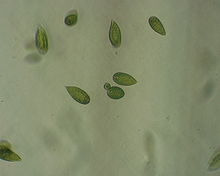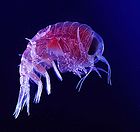- Raphidophyte
-
Raphidophytes Gonyostomum semen Scientific classification Domain: Eukaryota Kingdom: Chromalveolata Phylum: Heterokontophyta Class: Raphidophyceae
Chadefaud, 1950Raphidophytes (formerly referred to as Chloromonadophyceae and Chloromonadineae[1]) are a small group of eukaryotic algae that includes both marine and freshwater species.[2] All raphidophytes are unicellular, with large cells (50 → 100 μm) but no cell walls. Raphidophytes possess a pair of flagella, organised such that both originate from the same invagination (or gullet). One flagellum points forwards, while the other, covered in hair-like mastigonemes, points backwards across the cell surface, lying within a ventral groove. Raphidophytes contain numerous ellipsoid chloroplasts, which contain chlorophylls a, c1 and c2. They also make use of accessory pigments including β-carotene and diadinoxanthin. Unlike other heterokontophytes, raphidophytes do not possess the photoreceptive organelle (or eyespot) typical of this group.
In terms of ecology, raphidophytes occur as photosynthetic autotrophs across a range of aquatic systems. Freshwater species are more common in acidic waters, such as pools in bogs. Marine species often produce large blooms in summer, particularly in coastal waters. Off the Japanese coast, the resulting red tides often cause disruption to fish farms, although raphidophytes are not usually responsible for toxic blooms.
See also
- Chattonella
- Fibrocapsa
- Gonyostomum
- Haramonas
- Heterosigma
- Vacuolaria
References
- ^ Herbert Graffius, J. (1966). "Additions to Our Knowledge of Michigan Pyrrhophyta and Chloromonadophyta". Transactions of the American Microscopical Society 85 (2): 260–270. doi:10.2307/3224637. JSTOR 3224637.
- ^ Hoek, C. van den, Mann, D. G. and Jahns, H. M. (1995). Algae : An introduction to phycology, Cambridge University Press, UK.
SAR: Chromalveolata: Heterokont Ochrophyta/
(photosynthetic)PhaeistaHypogyristeaPinguiophyceae · Pelagophyceae · Actinochryso-/Dictyochophyceae: Florenciellales · Dictyochales · Rhizochromulinales · PedinellalesChrysistaEustigmataceae · Monodopsidaceae · PseudocharaciopsidaceaeAscoseirales · Cutleriales · Desmarestiales · Dictyotales · Discosporangiales · Ectocarpales · Fucales · Ishigeales · Laminariales · Nemodermatales · Onslowiales · Ralfsiales · Scytosiphonales · Scytothamnales · Sphacelariales · Sporochnales · Syringodermatales · TilopteridalesPhaeothamniophyceaePhaeothamniales · PleurochloridellalesRaphidophyceaeChattonella, Fibrocapsa, Gonyostomum, Haramonas, Heterosigma, VacuolariaHeterogloeales · Ochromonadales · Rhizochloridales · SynuralesBotrydiales · Mischococcales · Tribonematales · VaucherialesKhakistaBiddulphiophycidae · Chaetocerotophycidae · Corethrophycidae · Coscinodiscophycidae · Cymatosirophycidae · Lithodesmiophycidae · Rhizosoleniophycidae · ThalassiosirophycidaeBacillariophyceaeBacillariales · NaviculalesFragilariophyceaeFragilarialesFungus-like/
(nonphotosynthetic)PseudofungiBigyraOpalinata/SlopalinidaCategories:- Biological oceanography
- Heterokonts
- Planktology
- Chromalveolate stubs
Wikimedia Foundation. 2010.



